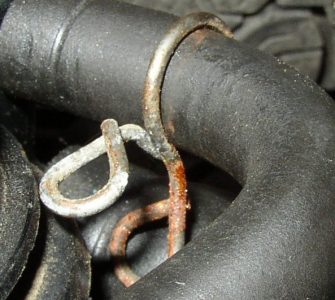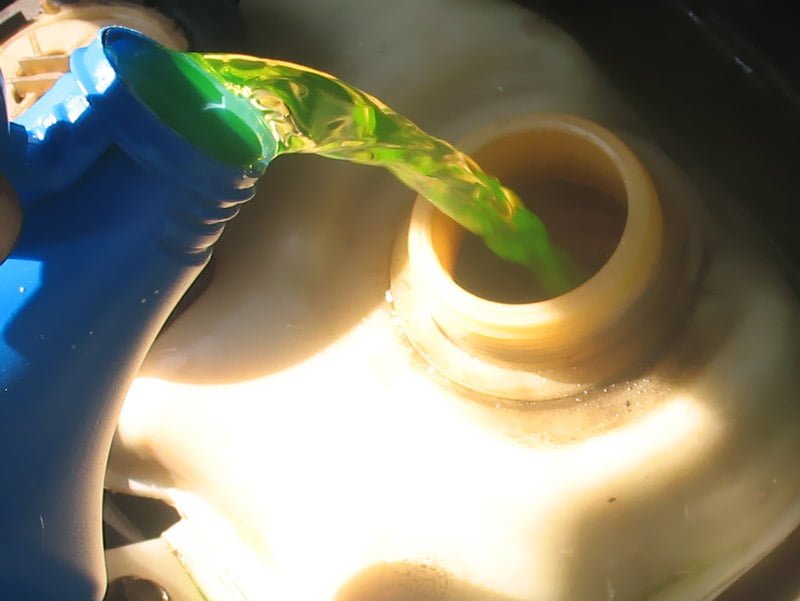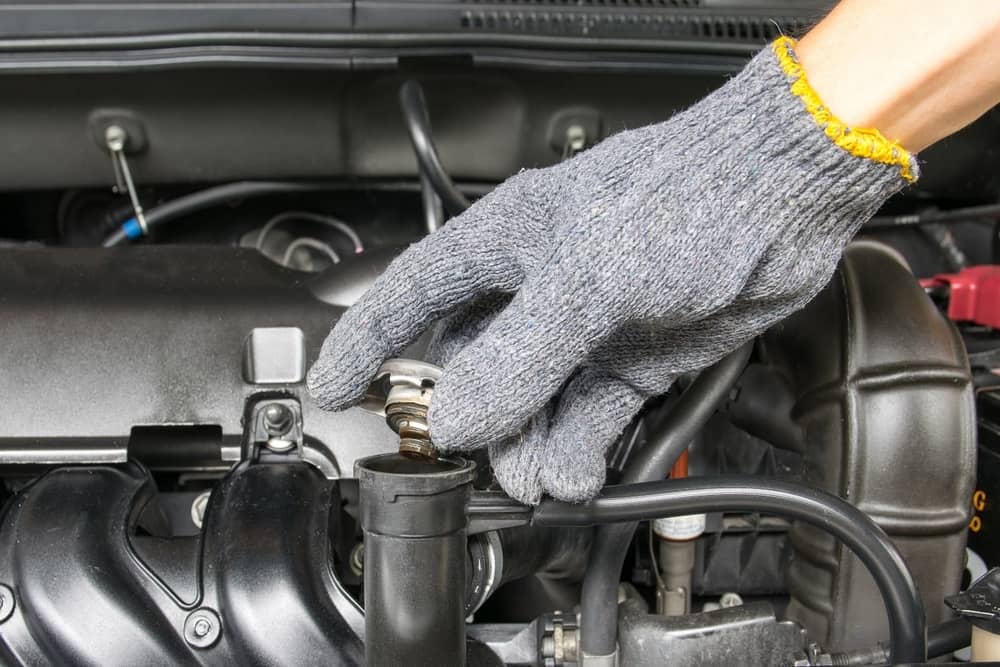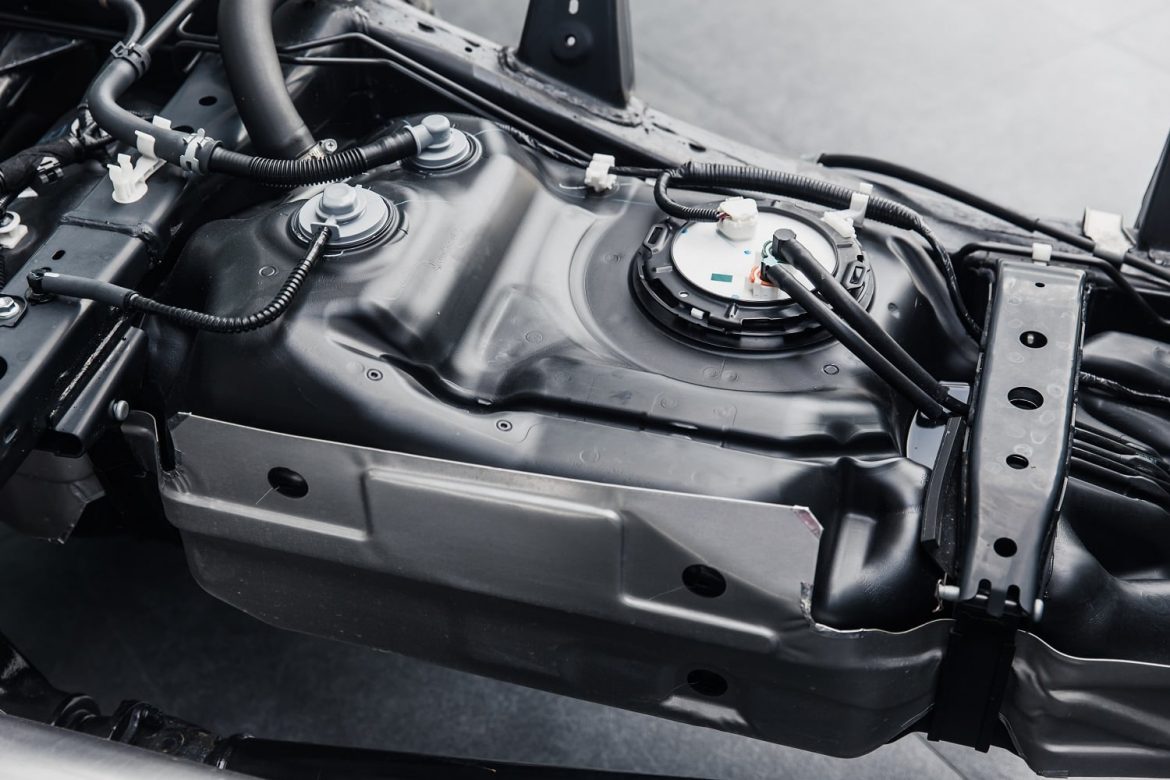 Leaks in your vehicle can be frustrating. However, even though leaks are frustrating, the time, energy and money that has to be spent to fix the leak can be even more overwhelming. If this is true of you, you probably have some leaks that have been going on for quite some time, and possibly some other neglected maintenance items on your vehicle. Your vehicle is just like many things in life where taking the easy road now may result in finding yourself stuck on the hard road. Literally.
Leaks in your vehicle can be frustrating. However, even though leaks are frustrating, the time, energy and money that has to be spent to fix the leak can be even more overwhelming. If this is true of you, you probably have some leaks that have been going on for quite some time, and possibly some other neglected maintenance items on your vehicle. Your vehicle is just like many things in life where taking the easy road now may result in finding yourself stuck on the hard road. Literally.
A leak in your car can cause permanent damage
Neglecting leaks in your vehicle’s cooling system is one of the quickest ways to cause permanent damage to your engine. By permanent damage, we mean the really high repair bill or scrap your car kind of damage. The temperatures in modern day engines are designed to be extremely high. In general, the hotter the burn in your combustion chamber, the more efficient your engine will be which means better mileage and more power. Depending on the type of engine you have in your car, the combustion gases may burn at 15000F up to 40000F so without adequate cooling, you can end up with problems very quickly. These problems can include melted pistons, or warped or even cracked engine blocks or cylinder heads.
If you allow a leak to persist in your engine’s cooling system, you will eventually get a low coolant level in your vehicle. Low coolant levels can lead to improper cooling simply due to the lack of cooling in your system which can lead to boiling in the engine block, and hot spots where coolant no longer reaches. These hot spots can create extreme temperature gradients which will put an extreme amount of stress on the components in your engine as well as the gaskets and seals.
One of the most common leak points in any engine is from the hoses that connect the radiator to the engine and the engine to the heater core. These hoses are usually made from rubber and over time can start to deteriorate even under normal operation. You can usually tell your hoses are in need of replacement simply by looking at them. If your cooling hoses are swollen, cracked, especially on the ends, or have bulges in them it is probably time to replace them. Some mechanics will recommend you change your radiator hoses at certain intervals since they are so vital to your vehicle’s health. While this is not bad advice, usually radiator hoses give ample warning before they fail by cracking, leaking or bulging.
How do I fix a radiator hose leak?
If you have a radiator hose leak, fixing it is usually pretty simple. Most auto parts stores carry hoses specific to your vehicle meaning they are constructed with the right length, shape and diameter to fit perfectly on your car. Once you’ve got the new hose, you can start the replacement process by draining your vehicle’s coolant. There should be a drain plug on the bottom of your radiator, usually on the driver’s side, or you can simply remove one end of the lower radiator hose. If you try this, just make sure you have a large catch basin under the hose because a lot of coolant will come out very quickly.
Once the system is drained of coolant, simply remove the old hose and install the new one. The hose may be attached with a spring clamp or band clamp. Either way, make sure you inspect the old clamp and replace it if it is rusty or weak along with your new hose.
With your new hose installed, you should consider flushing your cooling system before adding new coolant. If you had a hose that needed to be replaced, chances are it has left some deteriorated rubber in your cooling system. Also, if your vehicle is old enough to need new radiator hoses, it is probably also old enough to have quite a bit of scale and corrosion built up in the cooling system. Flushing your cooling system will help remove this debris and scale from your radiator and engine block to help bring your cooling system back up to its original flow rate and heat transfer abilities. This will help protect your engine from hot spots and overheating. Since you’ve already got your cooling system drained after a hose replacement, it is a great time to flush your cooling system without wasting good coolant.
The best way to flush your cooling system is to use BlueDevil Radiator Flush. BlueDevil Radiator Flush will deep clean your cooling system without harming any of the components, bringing your cooling system back to life.
BlueDevil Products can be found on Amazon.com or at AutoZone, Advance Auto Parts, O’Reilly Auto Parts, NAPA, and other major auto parts retailers.
42 responses to "How to Fix a Radiator Hose Leak"
42 Comments
Leave a Reply
Related Articles




Thanks for all the info. Single daughter just trying to make it without dad. He use to take care of all this and He passed away a year ago. Grateful for all He taught me or I wouldn’t have known to look here. Thanks guys.
Hi Becca just saying hi and I hope you no longer have any car issues.
Regards to your family.
Hlo Becca,
My condolences about your father. I am a father of two daughters whom I hope would feel the same love for me as you do for your father. I hope you were able to resolve the cooling system issue, and are happy motoring again.😉😊
I have a 2000 Monte Carlo SS and I have a leak on my upper hose to for the radiator what can I use til I can afford a new hose
Justin-
Thank you for asking about your Chevy Monte Carlo. Unfortunately, we do not manufacture a product for leaking radiator hoses. Replacing the hose would be your best option.
Thank you!
-BDP
A leaking hose can be fixable for me but the expense of a new radiator isn’t in my budget. What can i do for a crack on the left top side about a inch in one spot and cm just a inch further. Cant fix it for a month now what? Help please thank you.
Yvonne-
Based on your description, we recommend using the BlueDevil Radiator & Block Sealer (http://store.gobdp.com/radiator-block-sealer-00205/). As long as the vehicle will maintain idle for a full 45 minutes, and you are not losing more than about a quart of water/coolant, you would be a great candidate for the product.
Thank you!
-BDP
Hello , My car is overheating but when I blast the heat the gauge goes down I have antifreeze oozing from the top of a pipe connecting to the engine I know I have a leak somewhere bc when I put coolant in the reservoir it’s gone after an 12 hr shift but I don’t see any on the ground HELP
Bree-
Have you had the vehicle looked at by a certified ASE mechanic? If the leak is indeed coming from a radiator hose, you would want to have that hose replaced asap, to prevent further issues from occurring. Feel free to contact our technical support line at 888-863-0426 with any other questions.
Thank you!
-BDP
to be honest you should be making sure the radiator is full also people tend to top up the reservoir and not the radiator.
I have a 2000 Toyota Camry and there’s a bunch of like hoses/tube thingys that are like right next to the engine and I’m looskng coolant and my car is smoking cause the coolant is spraying out on the hot engine and it looks too crazy for a DIY project for me I don’t know what to do
James-
Thank you for asking about your Toyota Camry. Based on your description, we’d recommend bringing the vehicle into mechanic to have the hoses replaced. Have you noticed whether the coolant is spraying from the hose itself, or from the hose not being connected properly, or are you unsure as to where exactly the coolant is coming from? If you are not sure, you may want to have the vehicle diagnosed first, to make sure you are replacing/fixing only what is necessary.
Hope this helps!
-BDP
Hi, my question is can a brand new radiator hose be bad? I replace radiator and lower radiator hose on my 93 Suburban, and I still have a single drip every 15 seconds coming from The Middle approximately of the lower hose. I thought maybe it was coming from where that lower hose attaches to the engine, and so I made sure that was a good type seal, but I still have a single drip every 15 seconds or so. I have bled the system, and all of my connections are dry. The only thing I can imagine is that the new hose is defective. Could it be something else? Thank you.
Wendell,
Thanks for your question about your Suburban. It is certainly possible that the radiator hose you installed came with a hole or defect in it. Many auto parts stores acknowledge this possibility so you may try bringing the hose back and seeing if they will give you a new one. While you have the hose off, make sure you check the connections for any contamination, sharp spots or other irregularities at the connection to make sure you’re getting a good seal.
Thanks again for your question!
-BD Auto Pro
How much does it cost to replace a radiator hose?
Emma-
Replacing a radiator hose will typically cost $35-$65, depending on the vehicle.
Thank you!
-BDP
I have a small hole in radiator hose, planning to buy a new car this weekend.
As a temporary fix, can I use duct or electrical tape on it so I can go look for a car???
Yolanda-
You may be fine in using the temporary fix you have indicated to take short distances. You should monitor the temperature guage and top it off with water/coolant as needed.
Thank you!
-BDP
Do bluedevil seal water hose and oil leak as well
Browny-
Unfortunately, we do not manufacture a product intended to seal water hoses. The BlueDevil Oil Stop Leak is intended to treat rubber seals/gaskets. Where is the leak coming from? Please contact our technical support line at 888-863-0426 so that we can get a little better understanding of the vehicle’s condition and be able to make any appropriate recommendations.
Thank you!
-BDP
I located a leak at the point of hose meets engine…possible gasket? Doesnt look like a hose issue. I have a picture, any help?
Jessica-
Is the vehicle overheating at all or are you experiencing any other symptoms? Please contact our technical support line at 888-863-0426 so that we can get a little better understanding of the vehicle’s condition and be able to make any appropriate recommendations.
Thank you!
-BDP
My mom’s van is a toyota sienna LE and she is experiencing a coolant leak that’s so bad that before we go anywhere, we have to fill it and when we come back it’s empty. She won’t let me touch it but I want to get your opinion so let me give you the rundown, the hoses look fine but there is coolant leaking from the lip that the hose clamps onto. What do you think ? I personally think that the hose slipped off a little and the pressure is causing a leak (?) OR that a new radiator would do the trick?? Idk but if you could answer my question that would be great! Thanks!
Dylan-
Thank you for asking about your Mom’s Toyota Sienna. For the vehicle to be losing coolant as quickly as you’ve described, it must have something to do with a loose hose connection. If the clamp was on loosely or overtightened at any point, that would definitely explain the coolant leak. Based on how quickly the vehicle is losing coolant, replacing the radiator would be the most logical solution.
Thank you!
-BDP
Can a leak in the coolant hose cause permanent damage to the engine ? I keep seeing radiator
Lauren-
Yes, a leak in one of the coolant hoses, not addressed/replaced, could cause permanent damage to the engine. It is always best to remedy a situation like this immediately.
Thank you!
-BDP
I’ve had a 2005 Toyota Tundra for about 9 months. After I bought it I had all the hoses replaced. Now I’m losing coolant somewhere. I had the system pressure tested but they didn’t find anything. It’s not going into the oil. Any suggestions?
Steve-
Thank you for asking about your Toyota Tundra. Did the loss of coolant start happening shortly after the hoses were replaced? How quickly are you losing coolant? Please contact our technical support line at 888-863-0426 so that we can get a little better understanding of the vehicle’s condition and be able to make any appropriate recommendations.
Thank you!
-BDP
I have a 2004 bmw745li when I go over 40-50 mph my antifreeze hose comes off and all my coolant comes out idk what it is or what it can be any suggestions
Anthony-
Thank you for asking about your BMW 745li. It sounds as though you may have some pressure building up in the cooling system. Are you having any issues with overheating? Please contact our technical support line at 888-863-0426 so that we can get a little better understanding of the vehicle’s condition and be able to make any appropriate recommendations.
Thank you!
-BDP
My car overheated and stopped. Once it cooled off, I was able to start it again and drive it a block to a garage. Mechanic put new hose on (It had a hole and leaked radiator coolant) and replaced the coolant. Car rode fine back home, 12 miles. Next day, motor sounds sputtering and wobbly. Did I ruin my motor, or is this a new problem? It is a 2004 Hyundai Accent, with a newish timing belt. (only 4,000 miles on it).157k miles. Thanks
Tina-
Thank you for asking about your Hyundai Accent. This issue could be the result of the leaking hose you had prior to bringing it to the mechanic. The engine overheating is never something you want to see, and could have caused damage. Is the vehicle still overheating after leaving the mechanic? If so, you may want to bring it back for a proper diagnosis.
Thank you!
-BDP
Air keeps getting trapped into the cooling system, but I dont seem to have much coolant loss and can’t find a leak. It seems to start accumulating air in the upper radiator hose, and then pumps it into the thermostat, and im sure you can guess the rest. At the top of this page there’s a picture of a tiny pinch clamp for the overflow hose, im wondering if its possible that this could be the culprit, and that instead of sucking coolant back in when the car is off it may be sucking in air. Mine looks identical to the picture. I am not burning coolant, or at least, I dont have white smoke out of my exhaust, and beating on the car does not cause coolant loss. Leaving the car off overnight seems to build air, sometimes. I have already used blue devil heater core/head gasket sealant (using a thermostat housing without a thermostat) and it has not had any effect. I have successfully used the same product on previous cars rhe same way, I know I am not bungling the instructions, so I’m thinking its probably not the head gasket. Any ideas for me? Have replaced thermostat, lower rad hose, water pump, radiator, and bleeder valve. It is a VQ35 motor.
Louis-
Based on your description, it’s possible that you are getting combustion/exhaust gases pumping back into the cooling system. You can use a “Block Dye Tester” to confirm whether or not that is the case. Otherwise, checking for loose hose connections or faulty clamp spots may help pinpoint where the air is entering.
BlueDevil Head Gasket Sealer will still work if your vehicle is getting combustion/exhaust gases blowing into the cooling system and creating pressure. To give yourself the best overall chance of BlueDevil working successfully, in addition to the directions, you should remove the spark plug from the cylinder with the leak; this will be the spark plug from the cylinder with the low compression reading. If you are not sure which one that is, you may pull all of the spark plugs and will notice one will have a white-crystal-like substance on it and/or may look dirty; this is the plug you should pull. Leave that plug out for the 50 minute idle in order to relieve the pressure from building up and thus allowing the product to seal properly. Be sure to follow the guidelines for the proper amount to use based on the size of your cooling system.
Thank you!
-BDP
I have a 2008 GMC pickup. I started to see engine coolant on the garage floor. I thought the fluid was transmission fluid since it looks like the fluid leak is at the back of the motor. After some investigating, it appears to be coolant fluid. The transmission fluid is more red than the current fluid color which is more orange in color. It seems to match the coolant fluid with color and texture. Where might this leak coming from?
James-
Thank you for asking about your GMC. Based on your description, it would be difficult to say where the location of the leak is, without being at the vehicle. You may be able to locate the source of the leak, with a little more investigating, by checking for drips after turning the vehicle off. If you are unsure as to where the leak is coming from, it may be best to bring the vehicle to the mechanic for diagnosis.
Thank you!
-BDP
Hi my jetta 4 got a coolant leak on the lower hose it’s a tiny hole but leak constant my coolant bottle level even drop a bit I need urgent first aid please any glue or silicon that can seal that hot water hole?
Donovan-
Thank you for asking about your Volkswagen Jetta. Based on your description, the best option would be to replace the lower hose. Lower radiator hose replacement isn’t very expensive and is worth doing before letting the situation get worse and causing harm to the engine.
Thank you!
-BDP
Thanks for all your info. I have an Acura RDX 2011, and it Leaks Coolant!!! Not as much that it can be seen on floor but just a small drip very closed to Turbo part and when SUV is hot it drips on hot part, so it leaves smoke when I parl. Turbo is OK, it kicks in when driving and rhere is NO Engine light or Code, so all looks OK. Is there ANY solution to pour in the Radiator that goes all the way or just remains in Radiator? Mechanic says 8 hrs of just labor to get to that area to replace anything.
Syed-
Thank you for asking about your Acura. Based on your description, you would be a good candidate for the BlueDevil Radiator & Block Sealer. The product is intended for leaks that are seeping or lightly dripping. Feel free to contact our technical support line at 888-863-0426 with any other questions.
Thank you!
-BDP
Hi I have a Dodge 2007 and as soon as I put water in the radiator it leaks right where the motor is in the back could you please tell me what this could be thanks
Sandra-
Thank you for asking about your Dodge. If you are losing water just as quickly as you add it, more than likely, you are dealing with a cracked radiator, damaged thermostat housing or loose/faulty hose connections. Either way, a mechanic should be able to identify the source of the leak and make the appropriate repairs.
Thank you!
-BDP